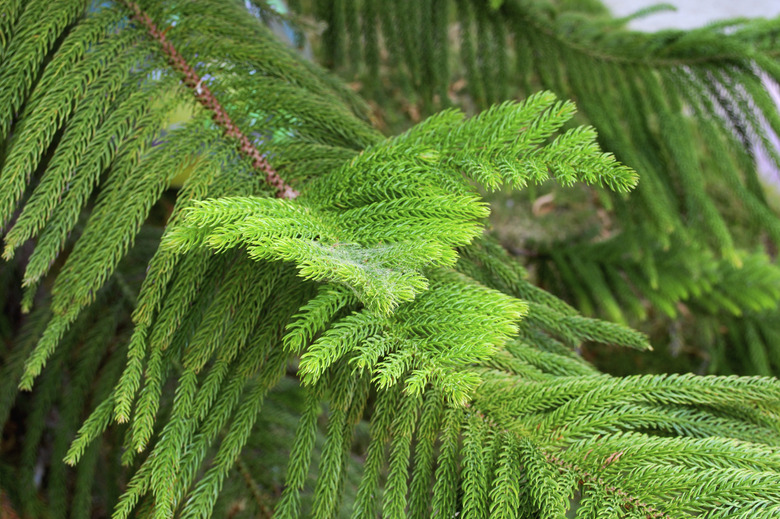How To Care For An Indoor Norfolk Pine Tree
We may receive a commission on purchases made from links.
Learning how to care for an indoor Norfolk pine tree helps your houseplant thrive. The Norfolk Island pine tree (Araucaria heterophylla), hardy in U.S. Department of Agriculture plant hardiness zones 9 through 11, enjoys popularity throughout the United States as a living indoor holiday tree.
Norfolk pine's lush green branches, pliable needles and deep rich coloration provide a verdant backdrop for colorful decorations as a holiday plant. After the holiday season, the trees make elegant houseplants year-round and can live for many years. Norfolk pine grows slowly, does not drop its needles, and resists pests and disease.
How to Care for an Indoor Norfolk Pine Tree
1. Choose the Proper Growing Conditions
Keep indoor Norfolk pine in a container with a mixture of equal parts potting soil, sand and peat moss. Good drainage is especially important, so choose a container that has several drainage holes. Use a saucer under the pot to catch excess water, and empty it after watering.
2. Pick a Suitable Location
Choose a location for your Norfolk that provides bright, filtered morning sunshine. To keep the bright foliage, it needs 2 hours or more of bright, indirect light each day. Norfolk pines don't like to be transplanted or relocated in their containers indoors, so pick a place where it can thrive. A window setting with plentiful natural light works best.
3. Rotate Your Norfolk Island Pine
Rotate your Norfolk island pine a quarter turn every week indoors to keep it growing upright and symmetrically. With light coming from only one direction, the tree grows toward it. Regular turns keep it from tilting to one side and growing in an irregular form.
4. Water When Soil Is Dry
Water Norfolk pine when the top inch of soil becomes dry. Water thoroughly so that water runs through the drainage holes and the entire soil area becomes moist. Never let Norfolk pines sit in standing water or their roots will rot. Empty the excess water out of the saucer after watering thoroughly. Allow the soil to dry before you water again. Norfolk pines do best when they have consistent water and moisture, so monitor the soil regularly.
5. Regulate the Temperature
Regulate temperatures to protect Norfolk pines from cold drafts and temperatures below 40 degrees Fahrenheit. Norfolk pines prefer nighttime temperatures near 50 degrees and daytime temperatures between 60 and 70 degrees. Position it away from heater or air conditioning vents and outside doors to prevent temperature fluctuations and drafts.
6. Use a Balanced Fertilizer
Fertilize Norfolk pines with a balanced, complete fertilizer during the tree's active period of growth, which is usually March through September. An all-purpose, water-soluble 10-10-10 fertilizer at half strength works well. Follow all label directions for frequency of application. Norfolk pine trees go through a dormant period during the cool winter months, and no fertilizer is needed.
7. Mist or Use a Humidifier
Mist your indoor Norfolk pine tree regularly to maintain high, consistent humidity. The trees crave humidity, especially on dry, winter days. A daily misting of water prevents browning of the needles. Consider using a humidifier if air is especially dry. You can also place the plant on a saucer filled with rocks and water for extra humidity, making sure that the water level is below the tops of the pebbles.
8. Prune Dead and Broken Branches
Prune off dead or broken branches using hand pruners, cutting back to the main trunk. Norfolk pine trees rarely need pruning. If you notice the needles becoming brown, it could be a sign of not enough humidity or the wrong amount of water, either too much or too little.
